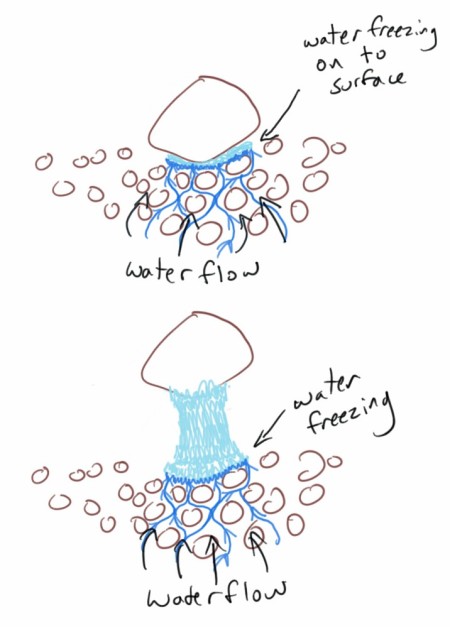Written at the request of the President of the International Glaciological Society, for the 2012 IGS meeting in Fairbanks. In the style of the classic The Cremation of Sam McGee by the great Robert W. Service.
The Story of Glacier Joe
There are strange things done ‘neath the midnight sun
By the folks who study ice
They’ll spend hours of time on a glacier climb
Just to check on some strange device.
With their crampons donned they ascend beyond
The realms where sane folk go
Yes, they’re all bizarre, but the oddest by far
Was the one called Glacier Joe.
The letters I.D. marked his sole degree–
“That’s ‘Doctor of Ice’,” he’d say
From a glacial perch he’d perform research
In his own peculiar way.
He’d carefully take his ablation stake
Back home at the start of spring
For the sunny glare might cause wear and tear
If snowmelt exposed the thing.
He hated to dig, so his snowpit rig
Was a big overclocked hair dryer
He never would change, though his numbers were strange
And his notebook often caught fire.
I answered an ad for a glacier grad
That’s how I joined Joe’s lab
He’d heard some stories ’bout inventories
And wanted to take a stab.
Our first sortie was altimetry
With a stopwatch and big flashlight
But so blindingly fast those light pulses went past
That our glaciers had negative height.
So next Joe raves about seismic waves
And runs out to buy T.N.T.
But it came to pass that each change in mass
Was just what we’d blown to debris.
He thought he’d shoot for the theory route
With area-volume scales;
So Joe would divide feet-long by leagues-wide
And end up with volume in bales.
Said Joe, “I guess the I.G.S.
Are a bunch of clever sots,
They’re hosting some sym-pos-i-um
So I’ll go expound my thoughts.”
He showed fifty-six slides dense as bricks
With text in Comic Sans
And spoke with such flair that the Session Chair
Dragged him offstage with both hands.
We went for beers with our glacial peers
And they told us of what they did
And all this news made Joe enthuse
Like a sweet-shop-dwelling kid.
So back we went to our field tent
To add to our data stores
Energized anew, we both set to
The task of drilling cores.
We drilled and cored and dug and bored
‘Til our hands were sore and tired
And I strained my eyes to analyze
The samples we acquired.
Well, day by day went on this way
And the data rose like the tide
But nary a bit of that data would fit
No matter how hard Joe tried.
“I’ll never know how the glaciers flow,”
Joe cried out in despair
“From the top to the bed, it’s all over my head–
I tell you, it just ain’t fair.”
“I know some folks can use full Stokes
But my models ain’t even one-D.
From densification to surface ablation
These glaciers befuddle me.”
And after this spiel, Joe turned on his heel–
And threw himself down a moulin!
With a rope from the sledge I raced to the edge
But by then he was long gone.
Unhappy and damp I returned to the camp
And pondered poor Joe’s fate;
Down the hole he’d been flushed to be frozen or crushed
It was awful to contemplate.
But later that night in the fading light
I awoke to a bellow grand
Like a trumpet brass from a deep crevasse
Saying “NOW I understand!”
“It’s all so clear from way down here!”
Exclaimed the voice with glee.
“Every wax and wane of stress and strain
Is an open book to me!”
“I can see each kernel of snow and firn’ll
Become a crystal grain
And each drop of melt makes its presence felt
In the branched subglacial drain.”
The ice folks say that to this day
A student or a seeker
Can strain an ear, and faintly hear
From beneath the ice: “Eureka!”
There are strange things done ‘neath the midnight sun
By those studying ice and snow
Yes, they’re all bizarre, but the oddest by far
Was the one called Glacier Joe.








